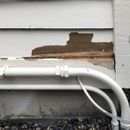How can I flash this belly band to prevent rot?
On the back of my house there is no roof overhang and during rains (pacific northwest), water sits on the edge of the cedar belly band and has rotted it and the siding board that touches it. I need to tear this out and redo it but what is the proper product and technique to flash it? And how do I meet the flashing to the corner boards? Do I need to bend an end dam?
Would it be better to replace the cedar board with a treated board?
The Tyvek and sheathing behind this are still good. Thanks for any help.
GBA Detail Library
A collection of one thousand construction details organized by climate and house part










Replies
LH,
I would replace that water table with a synthetic product like Boral or Azek. The correct way to install it is with a drip-flashing slipped under the siding above - ideally mounted on a rain screen.
Here is a picture of a similar detail on a house I built using Hardi Trim:
Thank you, Malcolm. That looks very nice.
Thank you all so much, this is really helpful. I have so much rain damage on my house to fix and I want to do the best I can to prevent further damage.
Is it really best to cut the Tyvek paper and bring it over the top of the drip flashing? It seems like this would leave a path at the 2 corners for water to get behind the paper? Or am I misunderstanding the diagram?
LH,
If you are doing the whole perimeter of the house you should cut back the corner trim boards so the water table and the flashing over it is continuous. If you are only doing the back elevation and intend to leave the corner trim, you should put end-dams in the flashing where they butt up to the trim.
Thanks, Malcolm. It would be difficult to redo the entire perimeter but I am wondering if it would be superior enough to justify the difficulty? Or will I be okay with bending the end dams and leaving the corner boards as they are?
LH,
If the siding on the other faces of the house don't show deterioration I'd leave well enough alone and just remediate that one board.
First it would be better if the top of the new board was angled down about 15° so water could not sit there.
Next there should be flashing on the wall going over the band board directing any water coming down the wall to come out the front and over the board.
The water resistant barrier should lap over the flashing tar paper or house wrap covered by the siding
Walta
Walta,
Now that I have the boards torn off and am getting a good look behind them, I am loathe to cut the Tyvek and lap it over the flashing that I am adding, because it has done such a good job of saving the sheathing underneath from water damage.
I was thinking of using a waterproof tape; sticking it on the Tyvek and lapping down over the flashing. Would this be a good idea or bad?
One of the details that is seldom shown: the lowest course of siding should sit about 1/4" above the flashing so that water drains off of the flashing and so that the siding does not sit in water on top of the flashing. I would modify Walter's recommendation above to say that the flashing should slope down at 15 degrees or so to drain properly. The trim board itself can be cut square.
Thank you, Peter, I can see how important this is.
The flashing has a 15 degree slope to it but it seems like when you fasten it to the wall the angle tightens up closer to a 90. It seems like I need to hold it up above the board a little more?
Also, what is the best way to fasten it to the wall? Thank you!
Sometimes on jobs because of scheduling, product availability or just poor workmanship there is improper lapping of materials. An after-the-fact remedy can be to use a fluid applied flashing on the top leg of the flashing, flashing it to the wrb. There are some very good fluid applied flashings now, this might be an option to cutting the wrb.